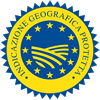Description
Cioccolato di Modica PGI is a chocolate product obtained from the processing of bitter cocoa paste and sugar.
Production Area
The production area for Cioccolato di Modica PGI is exclusively within in the territory of the municipality of Modica in the Province of Ragusa, in the Sicily region.
Production Method
The mixture is obtained by mixing the bitter cocoa paste and sugar, which can also include refined or whole raw cane sugar. Other optional ingredients may include: salt, cinnamon, vanilla, chilli pepper, nutmeg, natural citrus fruit flavourings, fennel, jasmine, ginger and fresh, dried or dehydrated pistachios, hazelnuts, almonds and citrus fruit. The use of other spices, natural flavourings and fresh, dried or dehydrated is also permitted. During the processing stage, the cocoa mass is melted in a bain-marie or in a tempering/melting machine, with a maximum of 50 °C at the centre of the mass. Once melted, the sugar is added to the mass together with any optional ingredients, without interrupting the mixing process that binds the ingredients together to create a uniform consistency. The product can be tempered before it is shaped, after which the mixture is portioned and poured into in special moulds. These are then agitated for one to three minutes, so as to give the product a uniform thickness and optimal compactness. Once the chocolate has cooled, the product is extracted from the moulds and packaged within a maximum of twelve hours.
Appearance and Flavour
Cioccolato di Modica PGI has a rectangular parallelepiped shape, with the sides tapering into a truncated pyramid; it has a maximum weight of 100 g. The chocolate is brown in colour with evident graininess due to the presence of sugar crystals. There may be visible cocoa butter bloom on the outer surface. It has a sweet taste with a bitter note, and a grainy or sandy texture. It is crunchy and melts easily in the mouth.
History
The city’s noble families started making Modica chocolate in the 1700s, as evidenced in the archival papers of a branch of the noble House of Grimaldi, which document the activities of chocolatiers as early as 1746. In the nineteenth century, the monasteries and religious institutes in the area also contributed to giving it great impetus and fame, as well as promoting its production and diffusion. A new important milestone was reached between the end of the nineteenth century and the beginning of the twentieth century: the cafes in Modica became laboratories for the production of chocolate.
Gastronomy
Cioccolato di Modica PGI can be kept in a cool, dry place for about eighteen months and is available year-round. As well as being established as an ingredient in cakes, biscuits and ice creams, it is also used in local savoury dishes. The characteristic parallelepiped shape of the bar makes it possible to make a cup of chocolate with each of the 25 g pieces, just by melting them in hot water.
Marketing
Cioccolato di Modica PGI is sold in single or multi-product packets, which must display the wording “Cioccolato di Modica” and the European Union PGI symbol. Each individual packet must bear the unique alphanumeric code assigned by the Control Body. Producers can also choose to put a special guarantee mark created with security printing by the Italian State Mint and Polygraphic Institute on the packaging of Cioccolato di Modica PGI.
Distinctive Features
The typical "cold" processing method used to produce Cioccolato di Modica PGI, combined with the carefully controlled temperature during the processing of the ingredients, ensures that the sugar crystals don’t melt, giving the product a perceivable graininess that is unique.




















![[VIDEO] DOP IGP di pani e dolci in grande espansione](https://www.qualivita.it/wp-content/uploads/2025/02/TG5-Dop-economy-210x118.jpg)




![[Roma] Presentazione: “Il Passaporto Digitale per il Cioccolato di Modica IGP”](https://www.qualivita.it/wp-content/uploads/2024/12/Passaporto-digitale-cioccolato-modica-210x118.jpg)






